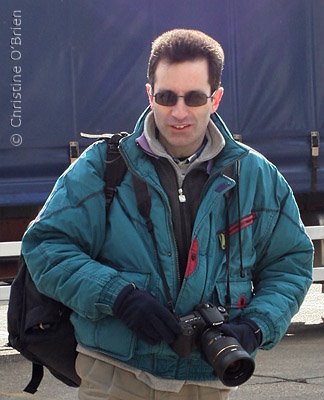Shooting through the cold - some thoughts on staying warm

The recent cold weather and particularly the extended period of snow has brought many wonderful photo opportunities. For me it coincided with discovering access to a new location, and I made the most of it. However, with the opportunities came challenges. None more so than how to stay warm for six to eight hours while still being able to take photos in these conditions. It isn't enough to be just tolerably warm. You need to be comfortable enough so as not to be distracted by the climate or the clothing. So here is a quick description of what has worked (and sometimes not) for me.
Let's work downwards (why not). At the start of the cold spell my choice of headgear was a thermal lined cap with a furry flap running from one side, around the back to the other side, which can be folded either up or down. It looks a bit like headgear that a Southpark kid might wear. Knowing that the flaps around the ears wouldn't be enough I also wore a snood (a sort of elongated hood without a jacket attached). The snood is made from a fleece which proved to be only slightly more windproof than chicken-wire. To remedy this I have been using a black silk balaclava more normally used by motorcyclists. Being silk it adds only little bulk, but does help retain heat. I'll be honest. I won't win any beauty or fashion contests looking like that, but I can live with the disappointment.
Now on to the main torso. Nothing special here. Mainly lots of layers. I do use a thermal cycling top, which certainly helps a lot. Most cycling clothing has longer arms and torso length to cope with the position in which cyclists ride. As well as its thermal properties it is also quite slippery on the outside surface. This is a help when there are more layers over it, as it allows layers to move more freely over each other and therefore movement is less restricted. I try to wear enough under my top layer so that I can open my jacket (to get at pockets for instance) without feeling the cold. Talking of jackets and moving freely, hoods are not ideal for photography as they inhibit turning the head to see what is around you. They encourage a rather blinked view (only optically of course).
And so to one of the most important parts - the hands. Last winter I got a pair of SealSkinz Ultra Grip gloves. They are insulating, though not enough for extreme conditions. They are also waterproof, breathable and dexterous and thanks to lot of little rubber dots on the fingers and palms have very good grip, even in the wet. To increase the retention of heat I use silk glove liners. As with the headgear the silk adds little in the way of bulk, but increases the warmth. I can operate all the controls on the camera with both of these pairs of gloves on. The only thing that requires their removal is changing a battery which isn't needed very often. On a seven hour trip the other day I didn't need to take them off once.
Trousers don't seem to be a problem for me. I just wear normal ones, but not jeans. Denim performs very poorly in cold weather and should be avoided.
Lastly to the feet. In fact I don't do much that is different because of the cold. I normally wear a pair of leather hiking boots with normal socks and then walking socks over. In summer the inner socks will be cotton and in winter they will be wool. The walking socks will also be wool. If you find that you are walking through a lot of snowy undergrowth then gaiters may be useful to stop water getting in around the top of the boot. I had some with me the other day but didn't use them.
Take from this what appeals and reject what does not. These things are very personal. Just don't stay inside when it's cold.
Image: Icy lake - Denham

0 Comments:
Post a Comment
<< Home